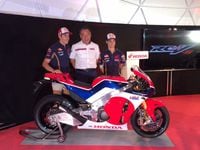When the time came for Q & A after the RC213V-S press conference, a moto-journalist from Great Britain raised his hand and asked, rather bluntly, why it has taken so long for the world to see this bike. Once translated into Japanese and the answer back into English, the response from the Honda executive was simply, "Do you really think it's taken a long time?"
The awkward pause that followed was just long enough for me to realize that this RC213V-S is really a matter of perspective.
The engineers and executives from Honda Japan involved with the project were predictably stoic in their presentation of the machine, but also clearly very proud. It was a kind of nervous pride, like a parent sending a child for the first day of school, and I couldn't help reflect on what it must be like. These people worked tirelessly to fabricate the pride of the MotoGP paddock, which has been ridden only by gods and undressed when the public's eyes are averted.
Honda engineers surely enjoyed prideful moments at dinner parties when friends would ask, "How much does it cost?" and they would laugh, "Oh no, no... it's not for sale." These same engineers were asked (more than once, I might add) their thoughts on the staggering $184,000 price tag, and they all unanimously answered that it seemed like a bargain. Sure, that's the PR coach talking, but to these people close to the project it must feel that way. The culmination of decades of Honda engineering, up for purchase; shocking!
Despite being cheapened by assigning a price, the painstaking processes continue. The majority of the parts for the RC213V-S are hand-made, in the same manufacturing practice as the MotoGP machine, meaning the team can only produce one bike per day. The pneumatic valve system and seamless gearbox have been replaced with “standard” parts from the RCV1000R (a la Nicky Hayden), but approximately 80 percent of the parts on this RCV-S streetbike are identical to the MotoGP bike's.
That includes electronics. How proud are the people at Honda of this machine? Well, chew on this: The RCV-S includes five ride modes, linked to individually tailored traction control settings, controlled using data from an on-board inertial measurement unit (IMU, or gyro). These are all firsts for a Honda production bike, and it was not mentioned in the presentation once. To avoid discussing a major progression in technology available to the public is to say that the release of this motorcycle is special to Honda. And that's fair.
In very sharp contrast to the bittersweet pride displayed by Honda, there is the other perspective. That of the consumer, enthusiast, or V-4 connoisseur. To these people, releasing a bike like this into the wild should be extremely exciting, but the excitement has been dulled by one, simple number: 99.6. As in, the number of horsepower Honda claim for the version destined for the US market.
How could a motorcycle marketed as a MotoGP bike for the street possibly excite people with less power than a middleweight naked bike? How is it possible that the “Sports Kit” (which releases the full 215 horsepower) will not be available to US consumer? Is it really the EPA’s fault? Why have other manufacturers gotten away with selling high-performance machines in the past without all of these regulations? What’s the point of owning a MotoGP replica that doesn’t replicate the most basic and primal piece of a grand prix machine?
These are the key questions swirling around the RCV-S at a time when we should be celebrating its mere existence. It has absolutely all of the other factors in place. Exquisitely made parts built by the same people who work on the race machine, test-ridden by Japanese GP legends Itoh and Ukawa, and a limited production run of around 200 bikes.
It's especially frustrating, and not altogether surprising, that this is coming from Honda. For many fans of two wheels, including myself, the mystique of Honda Racing Corporation has lasted a lifetime. HRC is the Willy Wonka chocolate factory of motorcycling, with a certain magic and mystery surrounding what it produces, from the machines of Dunlop and Spencer, to Doohan, and Rossi. To pull back the curtain now, after such recent dominance, only to reveal this neutered, 9,400-rpm version of the bike we see on TV, is crushingly disappointing.
Maybe we will be proven wrong. Maybe the gray market will be flooded with the race kits (estimated to be sold for about 12,000 euros, incidentally), and US buyers will have the opportunity to ride the true motorcycle hiding under all of the red tape. I really hope that’s the case, but not for the sake of the consumers. It’s those engineers standing behind this project that I feel have been betrayed. All of the power and meaning of their work is being marketed and then choked immediately by regulations. For such an amazing bike, from such an historic place, built by such talented people, to be lowered by the rest of society, would be a true injustice. And I hope it doesn’t stand.















/cloudfront-us-east-1.images.arcpublishing.com/octane/GTCXACQGJ5HAPDTGWUQKDEH44E.jpg)
/cloudfront-us-east-1.images.arcpublishing.com/octane/S35YGSEMEZB4BLTDJTSZPF4GLA.jpg)
/cloudfront-us-east-1.images.arcpublishing.com/octane/5UOT6HPX2JFMRJAX6EH45AR4MQ.jpg)
/cloudfront-us-east-1.images.arcpublishing.com/octane/OKWOJWAKP5EP3OACCRRWPCIX2Q.jpg)
/cloudfront-us-east-1.images.arcpublishing.com/octane/2WF3SCE3NFBQXLDNJM7KMXA45E.jpg)
/cloudfront-us-east-1.images.arcpublishing.com/octane/G4MG6OUCJNBSHIS2MVVOTPX65E.jpg)
/cloudfront-us-east-1.images.arcpublishing.com/octane/IIGGWFOTOJGB7DB6DGBXCCMTDY.jpg)
/cloudfront-us-east-1.images.arcpublishing.com/octane/QSTCM6AVEZA5JJBUXNIQ3DSOF4.jpg)
/cloudfront-us-east-1.images.arcpublishing.com/octane/U4I7G625B5DMLF2DVIJDFZVV6M.jpg)
/cloudfront-us-east-1.images.arcpublishing.com/octane/B6XD6LS6IVCQPIU6HXDJSM3FHY.jpg)
/cloudfront-us-east-1.images.arcpublishing.com/octane/ICL63FEDDRDTTMINYICCEYGMDA.jpg)
/cloudfront-us-east-1.images.arcpublishing.com/octane/FCGZHQXRBZFLBAPC5SDIQLVF4I.jpg)
/cloudfront-us-east-1.images.arcpublishing.com/octane/WNOB6LDOIFFHJKPSVIWDYUGOPM.jpg)

/cloudfront-us-east-1.images.arcpublishing.com/octane/X33NU3E525ECRHXLNUJN2FTRKI.jpg)
/cloudfront-us-east-1.images.arcpublishing.com/octane/6KKT5NNL2JAVBOXMZYS5ZO76YA.jpg)
/cloudfront-us-east-1.images.arcpublishing.com/octane/J5RKG5O455GMPGQRF2OG6LRT7A.jpg)
/cloudfront-us-east-1.images.arcpublishing.com/octane/GX2CIZKQVRH2TATDM26KFG2DAE.jpg)
/cloudfront-us-east-1.images.arcpublishing.com/octane/ZWIDYSAKQZHD5BHREMQILXJCGM.jpg)
/cloudfront-us-east-1.images.arcpublishing.com/octane/CYUHJZCTSJCH3MRAQEIKXK7SCQ.jpg)
/cloudfront-us-east-1.images.arcpublishing.com/octane/LKOFINY56FCXJCANJ5M7ZDQUBY.jpg)
/cloudfront-us-east-1.images.arcpublishing.com/octane/4NBPDACMWJH63JQYJVK3QRBDZI.jpg)
/cloudfront-us-east-1.images.arcpublishing.com/octane/KKHQHRR3FJGX7H2IPU6RALMWG4.jpg)
